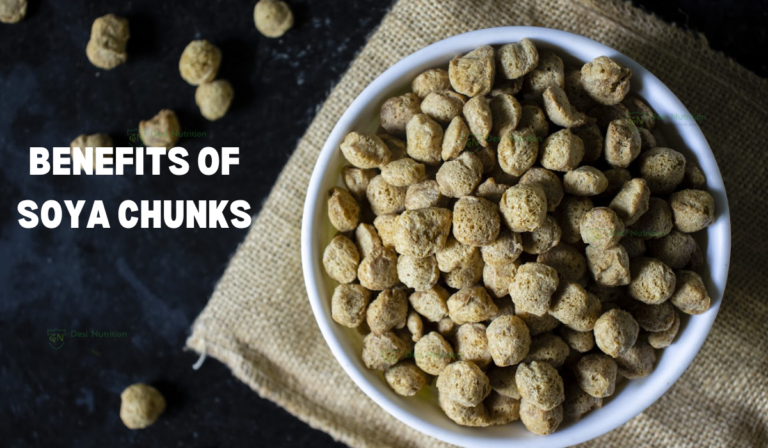Soya chunks are a protein-rich food product made from defatted soy flour. These small, textured nuggets are created by extracting the oil from soybeans, leaving behind a protein-rich substance that is then processed into various forms, including chunks. In this article, we will come to know about the many nutritional benefits of soya chunks for weight loss and overall well-being.
Soya chunks are a popular meat substitute, especially in vegetarian and vegan diets, due to their high protein content and versatility in cooking. In recent years, the culinary landscape has witnessed a growing shift towards healthier and more sustainable eating habits.
As individuals seek alternatives to traditional protein sources, soya chunks have emerged as a versatile and nutritious option, especially in vegetarian and vegan diets. Derived from soybeans, these small, textured nuggets pack a powerful nutritional punch, offering an array of health benefits while lending themselves to a myriad of culinary possibilities.
In this comprehensive exploration, we delve into the nutritional profile, health benefits, culinary versatility, and cooking tips associated with soya chunks.
Nutritional Profile:
At the core of soya chunks’ popularity lies their exceptional nutritional profile. Soy foods contain B vitamins, fiber, potassium, magnesium, and other high-quality protein.
These plant-based wonders are not only rich in protein but also boast a range of essential vitamins and minerals. Soy foods have nutrients in multiple values that help your body get enough nutrients.
Let’s break down the key components that contribute to the nutritional excellence of soya chunks:
1. Protein Content:
Soya chunks are renowned for their high protein content, making them an ideal choice for those looking to meet their protein requirements, particularly in vegetarian and vegan diets. Protein is crucial for various bodily functions, including muscle repair, immune system support, and enzyme production. Soya chunks provide a complete source of protein, containing all the essential amino acids required by the human body.
2. Iron and Calcium:
Soya chunks are excellent sources of iron and calcium, essential minerals that play vital roles in maintaining overall health. Iron is crucial for the formation of hemoglobin and preventing anemia, while calcium is essential for bone health and muscle function. Soya chunks, therefore, contribute significantly to meeting the daily requirements of these essential minerals.
3. Fiber:
Soya chunks are also a good source of dietary fiber. Fiber aids in digestion promotes a feeling of fullness, and helps regulate blood sugar levels. Including soya chunks in your diet can contribute to a healthy digestive system and support weight management.
4. Heart-Healthy Fats:
The fats present in soya chunks are predominantly polyunsaturated fats and omega-3 fatty acids. These heart-healthy fats contribute to cardiovascular well-being by reducing levels of LDL (low-density lipoprotein) cholesterol.
Health Benefits:

Beyond their impressive nutritional content, soya chunks offer a range of health benefits that make them a valuable addition to a balanced diet. Let’s explore some of these benefits:
1. Heart Health:
The heart-protective properties of soya chunks are attributed to the presence of soy protein, which has been shown to lower levels of LDL cholesterol. Additionally, the omega-3 fatty acids in soya chunks contribute to overall cardiovascular health. Including soya chunks in your diet may help reduce the risk of heart disease.
2. Bone Health:
The combination of calcium and vitamin D in soya chunks makes them beneficial for bone health. These nutrients are crucial for the development and maintenance of strong bones, reducing the risk of osteoporosis, especially in individuals who follow vegetarian or vegan diets.
3. Weight Management:
Soya chunks offer a satisfying and low-calorie protein source, making them an excellent choice for those aiming to manage their weight. The protein content in soya chunks helps promote a feeling of fullness, reducing overall calorie intake and supporting weight loss or maintenance goals.
4. Hormonal Balance:
Soy contains compounds called phytoestrogens, which are plant-based compounds that have a similar structure to estrogen. These phytoestrogens may contribute to hormonal balance in the body and have been studied for their potential role in reducing the risk of certain hormone-related cancers.
Culinary Versatility:

One of the standout features of soya chunks is their remarkable culinary versatility. They can adapt to various flavors and cooking styles, making them a favorite among chefs and home cooks alike.
Here are some ways in which soya chunks can be incorporated into a diverse range of dishes:
1. Curries and Stews:
Soya chunks are a perfect addition to curries and stews, absorbing the rich flavors of the spices and gravies. Whether in a classic Indian curry or a hearty vegetable stew, soya chunks contribute texture and protein to the dish.
2. Stir-Fries:
Stir-frying soya chunks with an array of vegetables is a quick and nutritious way to create a wholesome meal. The chunks retain their texture while absorbing the savory stir-fry sauces, resulting in a delicious and protein-packed dish.
3. Biryani and Pulao:
Make your rice-based dishes delicious by adding soya chunks to biryanis and pulao. Marinating the soya chunks with aromatic spices before incorporating them into these dishes enhances their flavor profile.
4. Salads:
Soya chunks can be used in salads to boost the protein content and add a satisfyingly chewy texture. Combine them with fresh vegetables, greens, and your favorite dressing for a nutritious and filling salad.
5. Burgers and Wraps:
As a meat substitute, soya chunks work exceptionally well in burgers, wraps, and sandwiches. They provide a protein-rich element that complements other ingredients, creating a satisfying and wholesome meal.
6. Soups and Pasta:
Soya chunks can be added to soups and pasta dishes for an extra protein boost. They pair well with a variety of broths and sauces, enhancing the nutritional value of these comfort foods.
7. Kebabs and Skewers:
Marinate soya chunks with spices and herbs, thread them onto skewers, and grill or bake for flavorful kebabs. This preparation method adds a smoky dimension to the soya chunks, making them an excellent option for barbecues or outdoor gatherings.
Cooking Tips:

To make the most of soya chunks in your culinary endeavors, consider the following cooking tips:
1. Rehydration:
Soya chunks typically come in a dehydrated form and need to be rehydrated before use. To do this, simply soak them in hot water for 15-20 minutes or until they become soft and plump. Drain and squeeze out excess water before incorporating them into your recipes.
2. Marination:
Enhance the flavor of soya chunks by marinating them with a mix of spices, herbs, and sauces. This step is particularly beneficial when preparing dishes like kebabs or grilled soya chunks. Marinating not only infuses the chunks with flavor but also helps tenderize them.
3. Incorporate in Various Dishes:
Experiment with different recipes to discover the versatility of soya chunks. From traditional curries to innovative salads and wraps, there are countless ways to incorporate these nuggets into your meals. Be open to exploring new flavors and culinary combinations.
4. Combination with Other Proteins:
For added texture and flavor complexity, consider combining soya chunks with other plant-based proteins like tofu or legumes. This combination can create a more satisfying and well-rounded dish.
5. Adjusting Texture:
Depending on the desired texture in your dish, you can control the softness or chewiness of soya chunks by adjusting the soaking time. Longer soaking times result in softer chunks, while shorter times retain a firmer texture.
Healthy Recipes of Soya Chunks

Here are a few healthy and tasty recipes that you can easily try at your home.
1. Soya Chunks and Vegetable Salad:
Ingredients:
– 1 cup soya chunks (boiled and drained)
– 1 cup mixed vegetables (carrots, bell peppers, cucumbers, cherry tomatoes)
– 1/2 cup boiled chickpeas
– 1/4 cup red onion, finely chopped
– 1/4 cup fresh coriander, chopped
– 1 tablespoon olive oil
– 1 tablespoon lemon juice
– Salt and pepper to taste
– 1 teaspoon mixed herbs (optional)
Instructions:
- In a large mixing bowl, combine the boiled soya chunks, mixed vegetables, boiled chickpeas, red onion, and fresh coriander.
- In a small bowl, whisk together olive oil, lemon juice, salt, pepper, and mixed herbs.
- Pour the dressing over the salad and toss everything together until well combined.
- Adjust salt and pepper according to taste.
- Refrigerate for at least 30 minutes before serving to allow the flavors to meld.
- Serve chilled as a healthy and protein-packed salad.
2. Soya Chunks Stir-Fry:
Ingredients:
– 1 cup soya chunks (boiled and drained)
– 1 cup mixed vegetables (broccoli, bell peppers, carrots, snap peas)
– 2 tablespoons low-sodium soy sauce
– 1 tablespoon olive oil
– 1 tablespoon ginger, minced
– 2 cloves garlic, minced
– 1 teaspoon sesame oil (optional)
– 1 tablespoon sesame seeds for garnish
– Salt and pepper to taste
Instructions:
- Heat olive oil in a wok or a large pan over medium-high heat.
- Add minced ginger and garlic, and sauté for a minute until fragrant.
- Add the mixed vegetables and stir-fry for 3-5 minutes until they are crisp-tender.
- Add the boiled soya chunks and continue stir-frying for another 2-3 minutes.
- Pour in the soy sauce and sesame oil (if using). Mix well to coat the ingredients evenly.
- Season with salt and pepper according to your taste.
- Garnish with sesame seeds and serve immediately.
These healthy soya chunks recipes are not only delicious but also rich in protein, fiber, and essential nutrients. Feel free to customize them with your favorite vegetables and spices.
Street-style soya chunk masala with vegetable stir fry
Soya Chunk Masala:
Ingredients:
– 1 cup soya chunks
– 1 large onion, finely chopped
– 2 tomatoes, pureed
– 1/2 cup yogurt
– 1 tablespoon ginger-garlic paste
– 1 teaspoon cumin seeds
– 1 teaspoon coriander powder
– 1 teaspoon cumin powder
– 1/2 teaspoon turmeric powder
– 1 teaspoon red chili powder (adjust to taste)
– 1 teaspoon garam masala
– Salt to taste
– Fresh coriander leaves for garnish
– Cooking oil
Instructions:
- Boil the soya chunks in hot water for 10-15 minutes until they become soft. Drain and squeeze out excess water.
- Heat oil in a pan, add cumin seeds and let them splutter. Add chopped onions and sauté until golden brown.
- Add ginger-garlic paste and sauté for a minute until the raw smell disappears.
- Add tomato puree and cook until the oil separates from the masala.
- Add turmeric powder, red chili powder, coriander powder, cumin powder, and salt. Mix well and cook for a few minutes.
- Add yogurt and cook until the masala is well blended and the oil starts to separate.
- Add boiled soya chunks and garam masala. Mix gently, ensuring the soya chunks are well coated with the masala. Cook for 10-15 minutes on low heat.
- Garnish with fresh coriander leaves and serve hot.
Vegetable Stir Fry:
Ingredients:
– 2 cups mixed vegetables (carrots, bell peppers, beans, peas, etc.), chopped
– 1 tablespoon soy sauce
– 1 tablespoon olive oil
– 1 teaspoon ginger, minced
– 1 teaspoon garlic, minced
– Salt and pepper to taste
– Sesame seeds for garnish (optional)
Instructions:
- Heat olive oil in a pan. Add minced ginger and garlic, and sauté until fragrant.
- Add the chopped vegetables and stir-fry on high heat for 5-7 minutes, ensuring they remain crisp.
- Add soy sauce, salt, and pepper. Mix well and continue stir-frying for another 2-3 minutes.
- Garnish with sesame seeds if desired.
Serving:
Serve the Soya Chunk Masala alongside the Vegetable Stir Fry for a delicious and healthy street-style meal. You can also pair it with rice or flatbreads of your choice. Enjoy!
Myth Around Soya Chunks
While soya chunks are generally recognized as a nutritious and versatile food, there are some myths and misconceptions surrounding them. It’s essential to address these myths to provide accurate information about soya chunks. Here are some common misconceptions:
1. Myth: Soya Chunks Cause Hormonal Imbalances:
One prevalent myth is that consuming soya chunks can lead to hormonal imbalances, particularly in men. This misconception stems from the presence of phytoestrogens in soy, which are plant compounds that have a similar structure to estrogen. However, numerous scientific studies have shown that moderate soy consumption does not have feminizing effects on men or disrupt hormonal balance.
2. Myth: Soya Chunks Are Unnatural or Highly Processed:
Another misconception is that soya chunks are heavily processed and, therefore, unnatural. While soya chunks undergo processing to remove the outer skin of soybeans and dehydrate them, this process is relatively minimal compared to some other processed foods. Soya chunks, in their basic form, are a whole food product, and their processing does not involve the addition of artificial preservatives or chemicals.
3. Myth: Soya Chunks Are High in Calories:
Some people may mistakenly believe that soya chunks are high in calories. In reality, soya chunks are relatively low in calories, especially when compared to some animal-based protein sources. Their high protein content and low-calorie profile make them a suitable option for individuals focused on weight management or seeking a protein boost without excess calories.
4. Myth: Soya Chunks Are Flavorless:
There is a misconception that soya chunks are bland and flavorless. Proper marinating and cooking techniques can transform soya chunks into delicious, flavorful components of a dish.
Over-Consumption of Soya Chunks
While soya chunks offer numerous health benefits when consumed in moderation, overconsumption can lead to certain issues. It’s crucial to maintain a balanced and varied diet to avoid potential drawbacks associated with excessive intake of any single food item.
Here are some issues to consider with the overconsumption of soya chunks:
- Excessive intake of soy chunks could theoretically lead to hormonal imbalances.
- If someone is not accustomed to a high-fiber diet and starts consuming large amounts of soya chunks, it’s advisable to gradually introduce them into the diet to allow the digestive system to adjust and not cause discomfort such as bloating, gas and abdominal discomfort.
- Individuals with known soy allergies like itching, hives, swelling, abdominal pain etc should avoid overconsumption of soya chunks.
- It’s important to consider overall protein intake from all sources, including animal and plant-based proteins, to avoid unnecessary strain on the kidneys.
- While moderate soy consumption is generally considered safe for individuals with normal thyroid function, those with thyroid disorders may need to be cautious about excessive soy intake because soy contains goitrogens that can interfere with thyroid functions.
It’s advisable for individuals with thyroid concerns to consult with their healthcare provider for personalized guidance. You can visit Desi Nutrition’s site for more information.
Frequently Asked Questions
Can we eat soya chunks daily?
Ans. Yes, you can incorporate soya chunks in your diet daily but you should consider adding more veggies, protein sources, healthy fats, and carbohydrates along with it to make a complete and balanced meal.
Do boiling soya chunks reduce protein?
Ans. The protein content of soya chunks is in the chunks that are not lost during cooking. Building soya chunks will add texture to it and you can cook it further easily.
Which is better: soya chunks or paneer?
Ans. You can incorporate soya chunks in your diet as a complementary side but it does not have enough protein as compared to paneer. So, if you have to choose between paneer or soya chunks when it comes to protein content, paneer is your correct choice.




